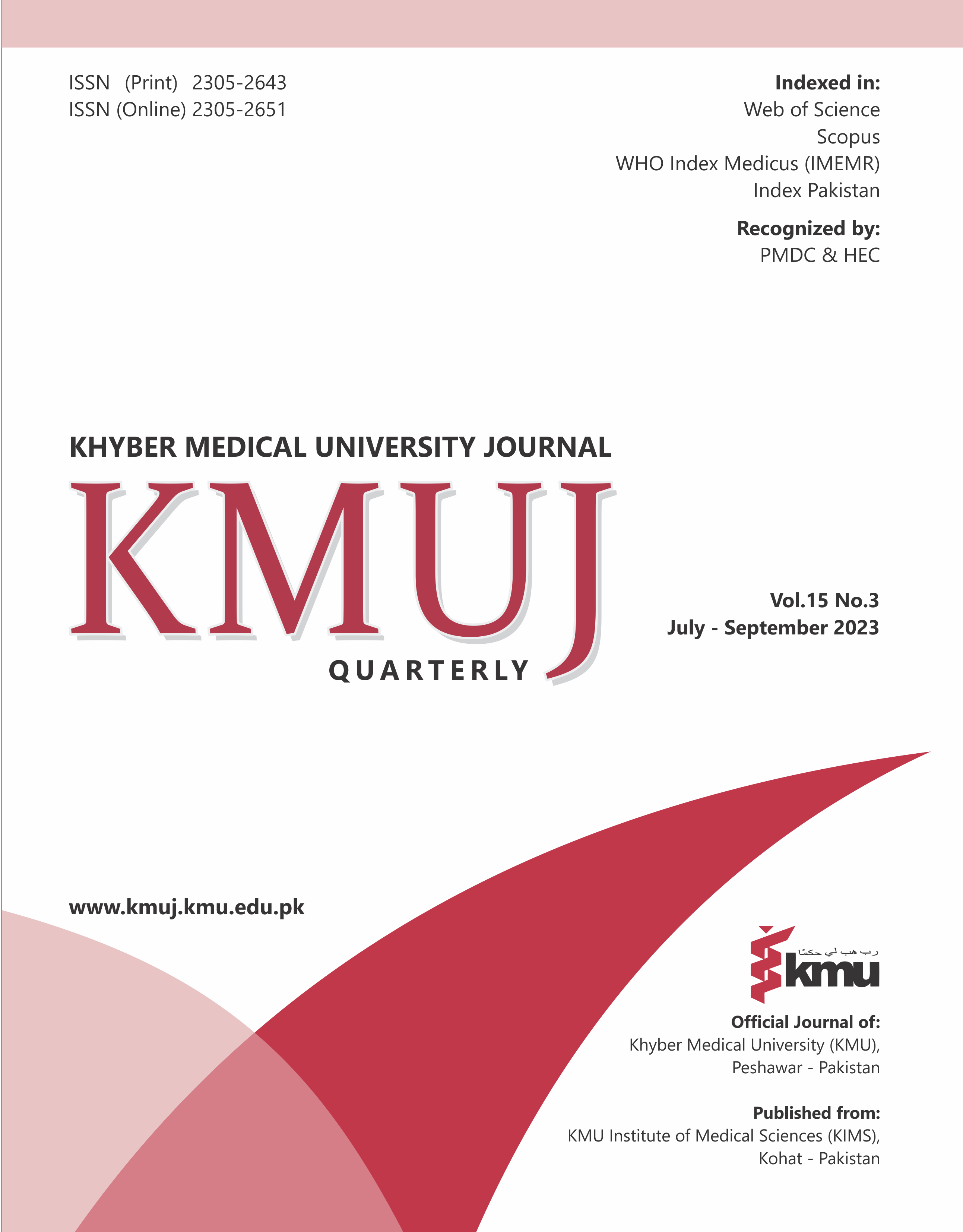Serum E-Cadherin level in various clinical variants of oral potentially pre-malignant disorders
Main Article Content
Abstract
OBJECTIVE: To compare the serum level of E-cadherin in clinical variants of oral potentially malignant disorders (OPMDs).
METHODS: This comparative cross-sectional study included eighty patients with OPMDs of Pakistani nationality, spanning all ages and both genders. Exclusion criteria encompassed cases that presented with squamous cell carcinoma and other non-OPMD pathologies. Age, gender, place of residence, lesion site, noxious habits, and habit duration were documented for all participants. The type of OPMDs was diagnosed by oral and maxillofacial surgeon and histopathologist. ELISA method was used for analysis of soluble E-cadherin levels in serum. Serum level of E-cadherin among various OPMDs were compared through One-way ANOVA.
RESULTS: Majority (n=64; 80%) of participants were using Snuff/Chewable tobacco and 12 (15%) were smokers. Leukoplakia (n=40; 50%) and Lichen Planus (n=28; 35%) were the common lesions and buccal mucosa (n=36; 45%) was the commonest site of lesion. Mean duration of lesion was 1.39±1.24 years. Mean E-cadherin was 26.34±3.67 ng/dl. The highest level of E-cadherin was found in carcinoma in-situ (32.0±2.33 ng/dl), oral submucous fibrosis (29.8±1.33 ng/dl) and Leukoplakia (26.7±3.11 ng/dl) and least in lichen planus (23.8±2.60 ng/dl) [p<0.001]. Post-hoc analysis showed statistically significant differences among various OPMDs (p<0.001) except between oral submucous fibrosis (OSF) and Leukoplakia (p=.108).
CONCLUSION: The expression of serum E-cadherin level is more in invasive OPMDs than less invasive OPMDs. These findings underscore the potential utility of E-cadherin as a biomarker for OPMD progression and prognosis. Further investigations are needed to explore the clinical implications and therapeutic relevance of these observed variations.
Article Details
Work published in KMUJ is licensed under a
Creative Commons Attribution 4.0 License
Authors are permitted and encouraged to post their work online (e.g., in institutional repositories or on their website) prior to and during the submission process, as it can lead to productive exchanges, as well as earlier and greater citation of published work.
(e.g., in institutional repositories or on their website) prior to and during the submission process, as it can lead to productive exchanges, as well as earlier and greater citation of published work.
References
Ray JG. Oral potentially malignant disorders: Revisited. J Oral Maxillofac Pathol 2017;21(3):326-7. https://doi.org/10.4103/jomfp.JOMFP_224_17
Amagasa T, Yamashiro M, Uzawa N. Oral premalignant lesions: from a clinical perspective. Int J Clini Oncol 2011;16(1):5-14. https://doi.org/10.1007/s10147-010-0157-3
Mortazavi H, Baharvand M, Mehdipour M. Oral potentially malignant disorders: an overview of more than 20 entities. J Dent Res Dent Clin Dent Prospects 2014;8(1):6. https://doi.org/10.5681/joddd.2014.002
Speight PM, Khurram SA, Kujan O. Oral potentially malignant disorders: risk of progression to malignancy. J Dent Res Dent Clin Dent Prospects 2018;125(6):612-27. https://doi.org/10.1016/j.oooo.2017.12.011
Ganly I, Patel S, Shah J. Early stage squamous cell cancer of the oral tongue—clinicopathologic features affecting outcome. Cancer 2012;118(1):101-11. https://doi.org/10.1002/cncr.26229
Carmeliet P, Jain RK. Molecular mechanisms and clinical applications of angiogenesis. Nature 2011;473(7347):298-307. https://doi.org/10.1038/nature10144
Orsenigo F, Giampietro C, Ferrari A, Corada M, Galaup A, Sigismund S, et al. Phosphorylation of VE-cadherin is modulated by haemodynamic forces and contributes to the regulation of vascular permeability in vivo. Nature Commun 2012;3(1):1-15. https://doi.org/10.1038/ncomms2199
Hashimoto T, Soeno Y, Maeda G, Taya Y, Aoba T, Nasu M, et al. Progression of oral squamous cell carcinoma accompanied with reduced E-cadherin expression but not cadherin switch. PLoS One 2012;7(1):e47899. https://doi.org/10.1371/journal.pone.0047899
Hazan RB, Qiao R, Keren R, Badano I, Suyama K. Cadherin switch in tumor progression. Ann N Y Acad Sci 2004;1014(1):155-63. https://doi.org/10.1196/annals.1294.016
Yardimci G, Kutlubay Z, Engin B, Tuzun Y. Precancerous lesions of oral mucosa. World J Clin Cases 2014;2(12):866. https://doi.org/10.12998/wjcc.v2.i12.866
Srivastava R, Sharma L, Pradhan D, Jyoti B, Singh O. Prevalence of oral premalignant lesions and conditions among the population of Kanpur City, India: A cross-sectional study. J Fam Med Primary Care 2020;9(2):1080-5. https://doi.org/10.4103/jfmpc.jfmpc_912_19
Dissemond J. Oral lichen planus: an overview. J Dermatological Treat 2004;15(3):136-40. https://doi.org/10.4103/0975-7406.155873
Cepowicz D, Zaręba K, Pryczynicz A, Dawidziuk T, Żurawska J, Hołody-Zaręba J, et al. Blood serum levels of E-cadherin in patients with colorectal cancer. Gastroenterol Rev 2017;12(3):186-91. https://doi.org/10.5114/pg.2017.70471
Zuo JH, Zhu W, Li MY, Li XH, Yi H, Zeng GQ, et al. Activation of EGFR promotes squamous carcinoma SCC10A cell migration and invasion via inducing EMT‐like phenotype change and MMP‐9‐mediated degradation of E‐cadherin. J Cell Biochem 2011;112(9):2508-17. https://doi.org/10.1002/jcb.23175
Pai K, Baliga P, Shrestha BL. E-cadherin expression: a diagnostic utility for differentiating breast carcinomas with ductal and lobular morphologies. J Clin Diagn Res 2013;7(5):840-4. https://doi.org/10.7860/JCDR/2013/5755.2954
Al Kassam D, Blanco I, de Los Toyos J, Llorente J. Diagnostic value of E-cadherin, MMP-9, activated MMP-13 and anti-p53 antibodies in squamous cell carcinomas of head and neck. Med Clin 2007;129(20):761-5. https://doi.org/10.1157/13113764
López-Verdín S, de la Luz Martínez-Fierro M, Garza-Veloz I, Zamora-Perez A, Grajeda-Cruz J, González-González R, et al. E-Cadherin gene expression in oral cancer: Clinical and prospective data. Med Oral Patologia Oral Cirugia Bucal 2019;24(4):e444. https://doi.org/10.4317/medoral.23029
